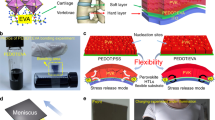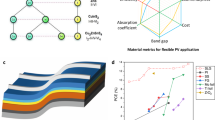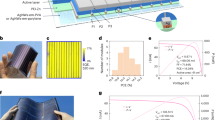Abstract
Solar energy represents one of the most abundant and yet least harvested sources of renewable energy. In recent years, tremendous progress has been made in developing photovoltaics that can be potentially mass deployed1,2,3. Of particular interest to cost-effective solar cells is to use novel device structures and materials processing for enabling acceptable efficiencies4,5,6. In this regard, here, we report the direct growth of highly regular, single-crystalline nanopillar arrays of optically active semiconductors on aluminium substrates that are then configured as solar-cell modules. As an example, we demonstrate a photovoltaic structure that incorporates three-dimensional, single-crystalline n-CdS nanopillars, embedded in polycrystalline thin films of p-CdTe, to enable high absorption of light and efficient collection of the carriers. Through experiments and modelling, we demonstrate the potency of this approach for enabling highly versatile solar modules on both rigid and flexible substrates with enhanced carrier collection efficiency arising from the geometric configuration of the nanopillars.
This is a preview of subscription content, access via your institution
Access options
Subscribe to this journal
Receive 12 print issues and online access
$259.00 per year
only $21.58 per issue
Buy this article
- Purchase on Springer Link
- Instant access to full article PDF
Prices may be subject to local taxes which are calculated during checkout





Similar content being viewed by others
References
Bai, Y. et al. High-performance dye-sensitized solar cells based on solvent-free electrolytes produced from eutectic melts. Nature Mater. 7, 626–630 (2008).
Kim, J. Y. et al. Efficient tandem polymer solar cells fabricated by all-solution processing. Science 317, 222–225 (2007).
Yoon, J. et al. Ultrathin silicon solar microcells for semitransparent, mechanically flexible and microconcentrator module designs. Nature Mater. 7, 907–915 (2008).
Law, M., Greene, L. E., Johnson, J. C., Saykally, R. & Yang, P. D. Nanowire dye-sensitized solar cells. Nature Mater. 4, 455–459 (2005).
Tian, B. Z. et al. Coaxial silicon nanowires as solar cells and nanoelectronic power sources. Nature 449, 885–889 (2007).
Kempa, T. J. et al. Single and tandem axial p–i–n nanowire photovoltaic devices. Nano Lett. 8, 3456–3460 (2008).
Möller, H. J. Semiconductors for Solar Cells (Artech House, 1993).
Beaucarne, G. et al. Epitaxial thin-film Si solar cells. Thin Solid Films 511, 533–542 (2006).
Van Nieuwenhuysen, K. et al. Epitaxially grown emitters for thin film crystalline silicon solar cells. Thin Solid Films 517, 383–384 (2008).
Schermer, J. J. et al. Thin-film GaAs epitaxial lift-off solar cells for space applications. Prog. Photovoltaics 13, 587–596 (2005).
Garnett, E. C. & Yang, P. D. Silicon nanowire radial p–n junction solar cells. J. Am. Chem. Soc. 130, 9224–9225 (2008).
Czaban, J. A., Thompson, D. A. & LaPierre, R. R. GaAs core–shell nanowires for photovoltaic applications. Nano Lett. 9, 148–154 (2009).
Tsakalakos, L. et al. Silicon nanowire solar cells. Appl. Phys. Lett. 91, 233117 (2007).
Kelzenberg, M. D. et al. Photovoltaic measurements in single-nanowire silicon solar cells. Nano Lett. 8, 710–714 (2008).
Fahrenbruch, A. L. & Bube, R. H. Fundamentals of Solar Cells: Photovoltaic Solar Energy Conversion (Academic, 1983).
Kayes, B. M., Atwater, H. A. & Lewis, N. S. Comparison of the device physics principles of planar and radial p–n junction nanorod solar cells. J. Appl. Phys. 97, 114302 (2005).
Spurgeon, J. M., Atwater, H. A. & Lewis, N. S. A comparison between the behavior of nanorod array and planar Cd(Se, Te) photoelectrodes. J. Phys. Chem. C 112, 6186–6193 (2008).
Hu, L. & Chen, G. Analysis of optical absorption in silicon nanowire arrays for photovoltaic applications. Nano Lett. 7, 3249–3252 (2007).
Lee, W., Scholz, R., Niesch, K. & Gosele, U. A template-based electrochemical method for the synthesis of multisegmented metallic nanotubes. Angew. Chem. Int. Ed. 44, 6050–6054 (2005).
Li, J., Papadopoulos, C. & Xu, J. Nanoelectronics—growing Y-junction carbon nanotubes. Nature 402, 253–254 (1999).
Fan, Z. Y. et al. Electrical and photoconductive properties of vertical ZnO nanowires in high density arrays. Appl. Phys. Lett. 89, 213110 (2006).
Steinhart, M. et al. Polymer nanotubes by wetting of ordered porous templates. Science 296, 1997–1997 (2002).
Masuda, H. et al. Highly ordered nanochannel-array architecture in anodic alumina. Appl. Phys. Lett. 71, 2770–2772 (1997).
Mikulskas, I., Juodkazis, S., Tomasiunas, R. & Dumas, J. G. Aluminum oxide photonic crystals grown by a new hybrid method. Adv. Mater. 13, 1574–1577 (2001).
Corwine, C. R., Pudov, A. O., Gloeckler, M., Demtsu, S. H. & Sites, J. R. Copper inclusion and migration from the back contact in CdTe solar cells. Sol. Energy Mater. Sol. Cells 82, 481–489 (2004).
Sze, S. M. Physics of Semiconductor Devices (Wiley–Interscience, 1981).
Marsillac, S., Parikh, V. Y. & Compaan, A. D. Ultra-thin bifacial CdTe solar cell. Sol. Energy Mater. Sol. Cells 91, 1398–1402 (2007).
Fan, Z. & Javey, A. Solar cells on curtains. Nature Mater. 7, 835–836 (2008).
Lungenschmied, C. et al. Flexible, long-lived, large-area, organic solar cells. Sol. Energy Mater. Sol. Cells 91, 379–384 (2007).
Nakamura, K., Fujihara, T., Toyama, T. & Okamoto, H. Influence of CdCl2 treatment on structural and electrical properties of highly efficient 2- μm-thick CdS/CdTe thin film solar cells. Japan. J. Appl. Phys. 1 41, 4474–4480 (2002).
Acknowledgements
We acknowledge G. F. Brown and J. Wu for help with simulations. This work was financially supported by Berkeley Sensor and Actuator Center. J. C. H. acknowledges an Intel Graduate Fellowship. All fabrication was carried out in the Berkeley Microfabrication Laboratory. The solar-cell experimental characterization was done at LBNL, and was supported by the Helios Solar Energy Research Center, which is supported by the Director, Office of Science, Office of Basic Energy Sciences of the US Department of Energy under Contract No. DE-AC02-05CH11231.
Author information
Authors and Affiliations
Contributions
Z.F., H.R., J.D., A.M., O.E., Y.-L.C. and A.J. designed the experiments. Z.F., H.R., J.D., A.M., O.E., Y.-L.C., J.C.H., T.T., L.A.R., S.N., K.Y., M.W., J.W.A. and A.J. carried out experiments. Z.F., P.W.L., J.W.A. and A.J. carried out simulations. Z.F., H.R., J.D., A.M., O.E., Y.-L.C., J.C.H., T.T., L.A.R., P.W.L., S.N., K.Y., J.W.A. and A.J. contributed to analysing the data. Z.F. and A.J. wrote the paper and all authors provided feedback.
Corresponding author
Supplementary information
Supplementary Information
Supplementary Information (PDF 986 kb)
Supplementary Information
Supplementary Movie (MPG 12148 kb)
Rights and permissions
About this article
Cite this article
Fan, Z., Razavi, H., Do, Jw. et al. Three-dimensional nanopillar-array photovoltaics on low-cost and flexible substrates. Nature Mater 8, 648–653 (2009). https://doi.org/10.1038/nmat2493
Received:
Accepted:
Published:
Issue Date:
DOI: https://doi.org/10.1038/nmat2493
This article is cited by
-
High performance visible-SWIR flexible photodetector based on large-area InGaAs/InP PIN structure
Scientific Reports (2022)
-
Well-defined nanostructuring with designable anodic aluminum oxide template
Nature Communications (2022)
-
Controlled filamentation instability as a scalable fabrication approach to flexible metamaterials
Nature Communications (2022)
-
Hydrogel Based Anodization: A Novel Technique to Form Ordered Nano-sized Porous Oxide Layer on the Aluminum Surface
JOM (2022)
-
Solar cell-integrated energy storage devices for electric vehicles: a breakthrough in the green renewable energy
Ionics (2022)



